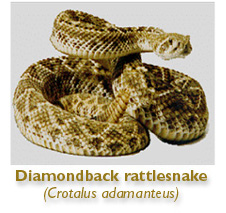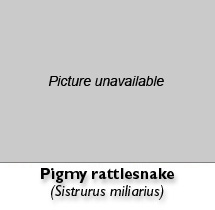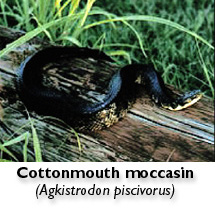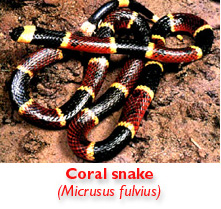 |
 |
 |
|||||||||||||||||||||
 |
|||||||||
 |
|||||||||
| The Diamondback rattlesnake is the largest and most dangerous of all poisonous snakes native to North America. They are recognized by the distinctive pattern of yellow-bordered diamond-shaped markings on the back. The tail is a rattling mechanism of brittle, button-shaped horny growth. The arrow-shaped head is much wider than the neck. They may commonly be found in flatlands, pine woods, abandoned fields and brushy, treed or grassy areas. The Pigmy rattlesnake or "ground rattler" normally measures less than eighteen (18) inches in length. The body is grayish in color, with several rows of rounded, dusky spots, often with a bit of reddish color along the mid-line of the back, near the head. This species is found in areas of pine and wiregrass but may be found in almost any locality where there are lakes, ponds or marshes. |
|||||||||
 |
|||||||||
 |
|||||||||
| The Coral snake normally measures less than 24 inches and is brightly colored with red, black and yellow bands. It has a black nose, and there are no red rings on the tail portion of the body. The band of color in the coral snake is always in sequence of black, yellow, and red. The coral snake is a small, slender-bodied species and prefers damp areas, living about rotting logs, old lumber piles, leaf mod and piles of decaying vegetation. The Cottonmouth moccasin is always found near water such as stream banks, river swamps and lake margins. The color pattern of the body is variable and may be olive, brownish or blackish. The body is stout for the length, the tail abruptly tapers, the broad head is much wider than the neck, and the mouth has a whitish interior lining -- hence the name "cottonmouth." |
|||||||||